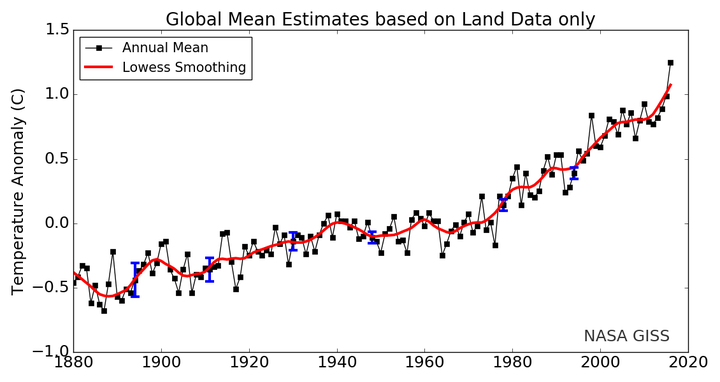For the fourth year in a row, I am offering a $25,000 climate bet to anyone who thinks he or she is smarter than a climate scientist. The “definition of insanity” meme is as absurd as it is overused. But in fact I don’t expect different results this time. I predict more of the same:
- Lack of courage by deniers and conspiracy cranks to accept the bet.
- Hand-wringing, insults, and excuses by bloggers.
- Another new global climatological temperature record.
Most deniers know full well that global warming is real, that it is caused by humans, and that it will continue. Why take a personal risk with actual money when it is easier and less expensive just to continue denying, blogging, and harassing scientists?
For 2015, I conceived the first bet in this series and donated seed money to a leading organization of scientific skeptics--the Committee for Skeptical Inquiry. CSI sponsored it and issued the challenge from our conference in Buffalo, NY. By chance, a leading organization of climate science deniers—The Heartland Institute—was having its annual meeting the same week, in Washington DC. So CSI put out a press release aimed directly to Heartland, starkly demonstrating the difference between scientific skeptics and science deniers.
Skeptics Dare Heartland Institute to Take Up $25,000 Climate Challenge
For Immediate Release: June 15, 2015
A leading science advocacy group is throwing down the gauntlet to the Heartland Institute, a group that claims that global warming stopped in 1998, with a stark, simple challenge: If the 30-year average global land surface temperature goes up in 2015, setting a new record, the Heartland Institute must donate $25,000 to a science education nonprofit.
The challenge is presented by the Committee for Skeptical Inquiry (CSI), a program of the Center for Inquiry, which held its “Reason for Change” conference last week in Buffalo, at the same time as Heartland’s own climate conference in Washington, DC. Heartland’s gathering opened with a keynote address by Sen. James Inhofe (R-OK), who believes that global warming is “the greatest hoax ever perpetrated on the American people.”
Among the key findings of a 2013 report published by Heartland was that “The level of warming in the most recent 15 year period [since 1998] is not significantly different from zero” and “natural variability is responsible for late twentieth century warming and the cessation of warming since 1998.” While the report’s authors dismissed global warming forecasts published by mainstream scientists, they have avoided making any testable predictions of their own.
“If anyone really thinks that human-caused global warming is a hoax, and that the climate has stopped heating up, they must also believe that temperatures will now stabilize or drop,” said Mark Boslough, a physicist and CSI Fellow who devised the challenge. “Well, that’s a testable claim, so let’s test it.”
“It’s time for the Heartland Institute to put its money where its exhaust pipe is,” said Ronald A. Lindsay, president and CEO of the Center for Inquiry, home of CSI. “If Earth’s climate gets hotter, and keeps getting hotter, the naysayers at Heartland should publicly own up and pay up.”
The Heartland Institute leaders pretended like they didn’t see our challenge and focused instead—in that record-setting hot year—on the subject of their conference (that global warming is a hoax).
For 2016, I issued another climate bet challenge (posted on New Year’s eve, 2015) but opened it up to any taker. There were none. A year later we learned that 2016 smashed the previous record, which had been set in 2015. So deniers avoided another humiliating $25,000 loss.
For 2017, I issued my challenge (on Dec. 10, 2016) to marketing professor Scott Armstrong, who is affiliated with the Heartland Institute. What Armstrong lacks in scientific knowledge is compensated by his expertise in persuasion through exploitation of emotion (a topic of his heavily-marketed book, and no doubt useful to the Heartland Institute). Armstrong has made a second career out of promoting an imaginary bet with Al Gore that is not about climate. He calls his non-climate non-bet “The Climate Bet”. I had hoped he would be interested in an actual bet about actual climate. He was not. So I re-issued the challenge to all takers on New Year’s Day, 2017.
For 2018, I’m doing the exact same thing I did a year ago (replacing “2017” with “2018”).
Mark Boslough (MB) hereby presents a challenge as to whether the Earth’s climate will set a new record high temperature in 2018. The challenge will be settled using the NASA GISS mean global land surface temperatures for the conventional climate averaging period (defined by the World Meteorological Organization as 30 years) ending on December 31, 2018. If the global average temperature does not exceed the mean temperature for an equal period ending on the same date in any previous year for which complete data exist, MB will donate $25,000 to a nonprofit to be designated by the accepting party. Otherwise, the accepting party will donate $25,000 to a science education nonprofit designated by MB.
As always, I don’t expect any takers who would be willing to give up $25,000 just to demonstrate that they mean what they say. The lack of interest from deniers in my previous three challenges makes it clear that (no matter how much they protest) they know that scientists are right about global warming. The blogging and posturing are just for show. I look forward to this year’s excuses, insults, and hand-wringing.

The solid black line is the global annual mean and the solid red line is the five-year lowess smooth. The blue uncertainty bars (95% confidence limit) account only for incomplete spatial sampling.
